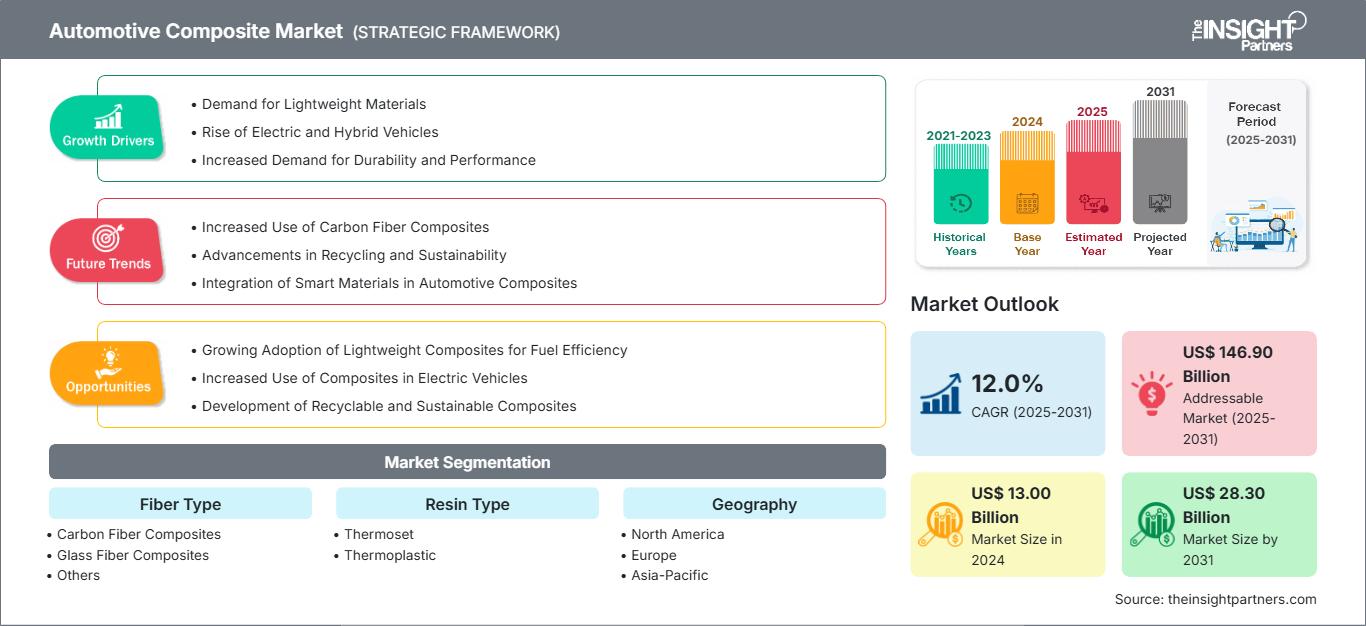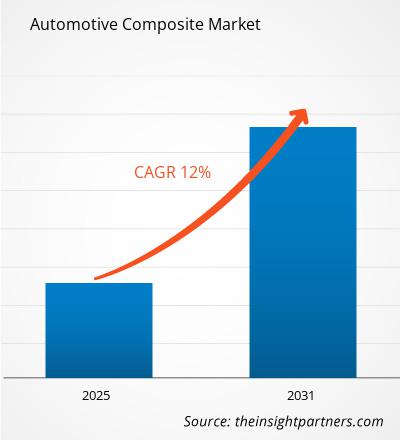Der Markt für Automobilverbundwerkstoffe soll von 13,00 Milliarden US-Dollar im Jahr 2024 auf 28,30 Milliarden US-Dollar im Jahr 2031 anwachsen. Der Markt wird im Prognosezeitraum voraussichtlich eine durchschnittliche jährliche Wachstumsrate (CAGR) von 12,0 % verzeichnen.
Der Bericht ist nach Fasertyp (Kohlefaserverbundwerkstoffe, Glasfaserverbundwerkstoffe und andere) segmentiert. Der Bericht enthält außerdem eine Analyse basierend auf Harztyp [Duroplast (Polyester, Vinylester, Epoxid, Polyurethan und andere), Thermoplast (Polypropylen, Polyethylen, Polyvinylchlorid, Polystyrol, Polyethylenterephthalat, Polycarbonat und andere)]. Basierend auf dem Fahrzeugtyp ist der Bericht in (Personenkraftwagen, leichte Nutzfahrzeuge (LCV), schwere Nutzfahrzeuge und Zweiräder und andere) segmentiert. Die globale Analyse ist weiter auf regionaler Ebene und nach den wichtigsten Ländern aufgeschlüsselt. Der Bericht bietet den Wert in USD für die oben genannte Analyse und Segmente.
Zweck des Berichts
Der Bericht „Automotive Composite Market“ von The Insight Partners zielt darauf ab, die aktuelle Landschaft und das zukünftige Wachstum sowie die wichtigsten treibenden Faktoren, Herausforderungen und Chancen zu beschreiben. Dies bietet verschiedenen Geschäftspartnern Einblicke, wie beispielsweise:
- Technologieanbieter/-hersteller: Um die sich entwickelnde Marktdynamik zu verstehen und die potenziellen Wachstumschancen zu kennen, damit sie fundierte strategische Entscheidungen treffen können.
- Investoren: Um eine umfassende Trendanalyse hinsichtlich der Marktwachstumsrate, der finanziellen Marktprognosen und der Chancen entlang der Wertschöpfungskette durchzuführen.
- Regulierungsbehörden: Um Richtlinien und Überwachungsaktivitäten auf dem Markt zu regulieren, mit dem Ziel, Missbrauch zu minimieren, das Vertrauen der Investoren zu wahren und die Integrität und Stabilität des Marktes aufrechtzuerhalten.
Marktsegmentierung für Verbundwerkstoffe für die Automobilindustrie: Fasertyp
- Kohlefaser-Verbundwerkstoffe
- Glasfaser-Verbundwerkstoffe
- Sonstige
Harztyp
- Duroplast
- Thermoplast
Sie erhalten kostenlos Anpassungen an jedem Bericht, einschließlich Teilen dieses Berichts oder einer Analyse auf Länderebene, eines Excel-Datenpakets sowie tolle Angebote und Rabatte für Start-ups und Universitäten.
Markt für Automobilverbundwerkstoffe: Strategische Einblicke

- Holen Sie sich die wichtigsten Markttrends aus diesem Bericht.Dieses KOSTENLOSE Beispiel umfasst Datenanalysen, die von Markttrends bis hin zu Schätzungen und Prognosen reichen.
Wachstumstreiber für den Markt für Automobil-Verbundwerkstoffe
- Nachfrage nach Leichtbauwerkstoffen: Die Automobilindustrie konzentriert sich zunehmend auf die Reduzierung des Fahrzeuggewichts, um die Kraftstoffeffizienz zu verbessern und die Emissionen zu senken. Automobil-Verbundwerkstoffe wie kohlenstofffaserverstärkte Kunststoffe und Glasfaser-Verbundwerkstoffe bieten Leichtbaulösungen ohne Kompromisse bei Festigkeit und Haltbarkeit. Ihr Einsatz in Karosserieteilen, Fahrgestellen und Innenräumen nimmt zu.
- Aufstieg von Elektro- und Hybridfahrzeugen: Die wachsende Beliebtheit von Elektrofahrzeugen (EVs) und Hybridfahrzeugen, die leichte Materialien benötigen, um die Batterieleistung und Reichweite zu maximieren, treibt die Nachfrage nach Automobil-Verbundwerkstoffen. Diese Materialien tragen zur Verbesserung der Gesamtenergieeffizienz bei und bieten ein verbessertes Verhältnis von Festigkeit zu Gewicht.
- Steigerte Nachfrage nach Haltbarkeit und Leistung: Automobil-Verbundwerkstoffe sind bekannt für ihre Haltbarkeit, Korrosionsbeständigkeit und Fähigkeit, rauen Umweltbedingungen standzuhalten. Mit der technologischen Weiterentwicklung von Fahrzeugen steigt der Bedarf an Materialien, die hohe Leistung bieten und gleichzeitig leicht, korrosionsbeständig und kostengünstig sind.
Zukünftige Trends im Markt für Verbundwerkstoffe für die Automobilindustrie
- Verstärkter Einsatz von Kohlefaserverbundwerkstoffen: Da sich die Automobilhersteller auf die Verbesserung der Kraftstoffeffizienz und die Reduzierung des Fahrzeuggewichts konzentrieren, wird erwartet, dass sich Kohlefaserverbundwerkstoffe weiter verbreiten. Diese Materialien bieten ein hervorragendes Verhältnis von Festigkeit zu Gewicht und verbessern so die Fahrzeugleistung und Energieeffizienz, insbesondere bei Elektrofahrzeugen, Luxusautos und Hochleistungssportwagen.
- Fortschritte bei Recycling und Nachhaltigkeit: In Zukunft wird der Schwerpunkt bei Verbundwerkstoffen für die Automobilindustrie auf der Verbesserung der Recyclingfähigkeit von Verbundwerkstoffen liegen. Die Entwicklung von Verbundwerkstoffen, die leichter zu recyceln und nachhaltiger sind, wird das Wachstum im Automobilsektor vorantreiben, da Umweltbelange und Abfallreduzierung immer wichtiger werden.
- Integration intelligenter Materialien in Verbundwerkstoffe für die Automobilindustrie: Der Aufstieg intelligenter Verbundwerkstoffe mit selbstheilenden Eigenschaften, Sensoren und anderen integrierten Funktionen wird die Automobilindustrie voraussichtlich revolutionieren. Mithilfe dieser Materialien kann der Zustand von Fahrzeugen überwacht, kleinere Schäden repariert und die Gesamtleistung des Fahrzeugs verbessert werden, was zu einer längeren Lebensdauer und geringeren Wartungskosten führt.
Marktchancen für Verbundwerkstoffe im Automobilbereich
- Zunehmende Verwendung von Leichtbau-Verbundwerkstoffen zur Kraftstoffeffizienz: Da die Automobilhersteller ihren Fokus auf die Verbesserung der Kraftstoffeffizienz legen, stellen Leichtbau-Verbundwerkstoffe wie Kohlefaser und Glasfaser eine wichtige Marktchance dar. Diese Materialien werden in Karosserieteile, Fahrgestelle und Innenraumkomponenten integriert, um Gewicht zu reduzieren, die Leistung zu verbessern und gesetzliche Emissionsziele zu erreichen.
- Zunehmender Einsatz von Verbundwerkstoffen in Elektrofahrzeugen: Die Umstellung auf Elektrofahrzeuge (EVs) bietet erhebliche Chancen für den Markt für Verbundwerkstoffe im Automobilbereich. Elektrofahrzeuge benötigen Leichtbaumaterialien, um die Reichweite und Effizienz der Batterie zu maximieren, und Verbundwerkstoffe sind für diesen Zweck ideal. Mit der zunehmenden Produktion von Elektrofahrzeugen steigt auch die Nachfrage nach fortschrittlichen Verbundwerkstoffen in Bereichen wie Batteriegehäusen, Strukturkomponenten und Innenraumelementen.
- Entwicklung recycelbarer und nachhaltiger Verbundwerkstoffe: Mit zunehmender Betonung der Nachhaltigkeit wächst der Markt für recycelbare und umweltfreundliche Verbundwerkstoffe im Automobilbereich. Hersteller entwickeln innovative biobasierte Verbundwerkstoffe und recycelbare Materialien, die sowohl Leistungs- als auch Umweltanforderungen erfüllen und so lukrative Chancen im Bereich der grünen Automobilindustrie bieten.
Regionale Einblicke in den Markt für Automobilverbundwerkstoffe
Die Analysten von The Insight Partners haben die regionalen Trends und Faktoren, die den Markt für Automobilverbundwerkstoffe im Prognosezeitraum beeinflussen, ausführlich erläutert. In diesem Abschnitt werden auch die Marktsegmente und die geografische Lage in Nordamerika, Europa, dem asiatisch-pazifischen Raum, dem Nahen Osten und Afrika sowie Süd- und Mittelamerika erörtert.
Umfang des Marktberichts für Automobilverbundwerkstoffe
| Berichtsattribut | Einzelheiten |
|---|---|
| Marktgröße in 2024 | US$ 13.00 Billion |
| Marktgröße nach 2031 | US$ 28.30 Billion |
| Globale CAGR (2025 - 2031) | 12.0% |
| Historische Daten | 2021-2023 |
| Prognosezeitraum | 2025-2031 |
| Abgedeckte Segmente |
By Fasertyp
|
| Abgedeckte Regionen und Länder | Nordamerika
|
| Marktführer und wichtige Unternehmensprofile |
|
Dichte der Marktteilnehmer für Automobilverbundwerkstoffe: Verständnis ihrer Auswirkungen auf die Geschäftsdynamik
Der Markt für Automobilverbundwerkstoffe wächst rasant. Die steigende Nachfrage der Endverbraucher ist auf Faktoren wie veränderte Verbraucherpräferenzen, technologische Fortschritte und ein stärkeres Bewusstsein für die Produktvorteile zurückzuführen. Mit der steigenden Nachfrage erweitern Unternehmen ihr Angebot, entwickeln Innovationen, um den Bedürfnissen der Verbraucher gerecht zu werden, und nutzen neue Trends, was das Marktwachstum weiter ankurbelt.

- Holen Sie sich die Markt für Automobilverbundwerkstoffe Übersicht der wichtigsten Akteure
Wichtige Verkaufsargumente
- Umfassende Abdeckung: Der Bericht analysiert umfassend Produkte, Dienstleistungen, Typen und Endnutzer des Marktes für Automobilverbundwerkstoffe und bietet so einen ganzheitlichen Überblick.
- Expertenanalyse: Der Bericht basiert auf dem umfassenden Verständnis von Branchenexperten und Analysten.
- Aktuelle Informationen: Der Bericht gewährleistet Geschäftsrelevanz durch die Berichterstattung über aktuelle Informationen und Datentrends.
- Anpassungsoptionen: Dieser Bericht kann an spezifische Kundenanforderungen angepasst werden und passt sich so optimal an die Geschäftsstrategien an.
Der Forschungsbericht zum Markt für Automobilverbundwerkstoffe kann daher dabei helfen, die Branchensituation und die Wachstumsaussichten zu entschlüsseln und zu verstehen. Obwohl es einige berechtigte Bedenken geben mag, überwiegen die Vorteile dieses Berichts tendenziell die Nachteile.
- Historische Analyse (2 Jahre), Basisjahr, Prognose (7 Jahre) mit CAGR
- PEST- und SWOT-Analyse
- Marktgröße Wert/Volumen – Global, Regional, Land
- Branchen- und Wettbewerbslandschaft
- Excel-Datensatz
Aktuelle Berichte
Erfahrungsberichte
Grund zum Kauf
- Fundierte Entscheidungsfindung
- Marktdynamik verstehen
- Wettbewerbsanalyse
- Kundeneinblicke
- Marktprognosen
- Risikominimierung
- Strategische Planung
- Investitionsbegründung
- Identifizierung neuer Märkte
- Verbesserung von Marketingstrategien
- Steigerung der Betriebseffizienz
- Anpassung an regulatorische Trends




















 Kostenlose Probe anfordern für - Markt für Automobilverbundwerkstoffe
Kostenlose Probe anfordern für - Markt für Automobilverbundwerkstoffe